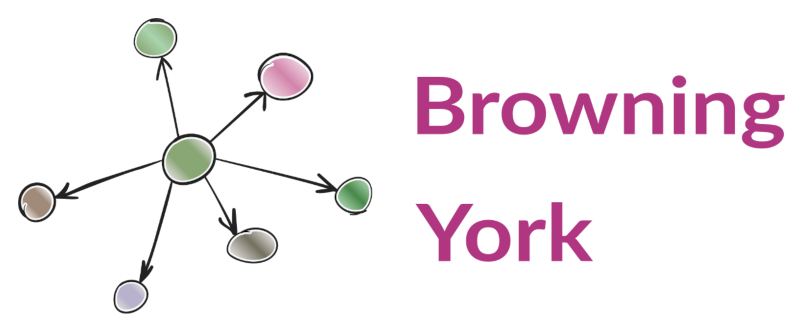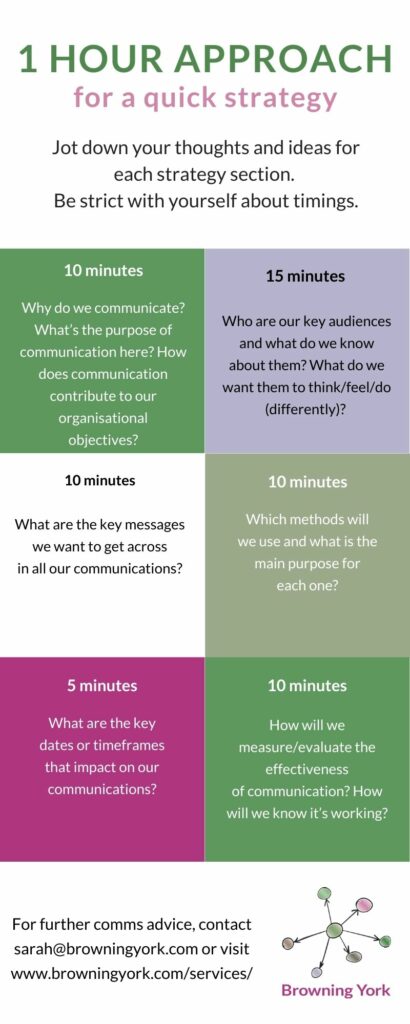I often work with clients who tell me they really want to work from a comms strategy but they don’t have time to write it. Because I am not (usually) involved in the day-to-day delivery of communications at their organisation, I have the time and space to do the strategic thinking.
I can take a step back and look at the bigger picture of what communication can do for them.
But what if you don’t have the budget or buy-in to bring someone like me in to do it for you?
- Should you give up on your dream of a shiny new communications strategy?
- Must you accept the tactical reality of a busy Communication Manager’s role?
- Is it even possible to achieve the holy grail of a strategic approach to communication without mastering time travel so that you create extra hours in your day?
In short, my answers to these questions are:
- No, you shouldn’t give up.
- No, you shouldn’t just accept it.
- Yes, you can have a strategy without time travel.
I believe it is possible to write a comms strategy more quickly than most of us realise.
Be pragmatic
In an ideal world we would all love an in-depth, minutely researched strategy, but if that’s not going to happen any time soon, something is better than nothing. If you start with something, no matter how brief, you can always build on it later.
If you have a basic starting point and you ensure all communication activity aligns with that, you have a chance to demonstrate to stakeholders the difference it makes. In turn, you can open up the conversation about the impact of a strategy and make the case for investment of time and/or resources in developing it further.
Here are my top 3 suggestions for writing a strategy quickly:
The 1-hour approach
Set aside one hour to jot down your thoughts on each section of your strategy. Be strict with yourself about the number of minutes you spend considering each section. That way you will make it to the end, rather than going into too much detail at the start.
In my experience, most Communication Managers know the key elements of the strategy they would ideally adopt. This approach gives you focussed time to put down those thoughts. You might also find that working at speed stops you talking yourself out of things.
Suggested timeline:
The 20 minutes a day approach
Taking a whole hour out of your day may not be possible for everyone. Especially if you’re a team of one, covering a number of responsive channels. But 20 minutes a day to consider one section of the strategy may fit better into your timetable.
If you’re going to try this, I highly recommend you do it every day for a week, ideally at the same time each day. By taking a 24 hour break between sections, you will be allowing time for reflection and further development of ideas across the week. Again, be strict with yourself about timings.
Suggested timeline:
Monday – Why do we communicate? What’s the purpose of communication here? How does communication contribute to our organisational objectives?
Tuesday – Who are our key audiences and what do we know about them? What do we want them to think/feel/do (differently)?
Wednesday – What are the key messages we want to get across in all our communications?
Thursday – How does communication work in practice? Which channels will we use and what are the timeframes to take note of?
Friday – How will we know our communications are working?
The ‘speed-dating’ approach
A great way to write a comms strategy quickly is to find a space where you can collaborate with others. This could be a digital space or in a physical room, if you are now back to face to face working. Create a digital whiteboard (or put up pieces of paper on the walls) to represent each of the strategy sections listed above.
Give yourself 3 minutes to jot down words, phrases and even the pictures that come to mind for the first section. Then move to the next one and do it again. As with the one hour approach, you will probably find that the focus of a set time period stops the doubt and second-guessing.
Working with others
These approaches are essentially a way to capture just your thoughts, without involving others. This isn’t the perfect way to develop a strategy, but sometimes you need to be pragmatic to move things forward. This will give you a starting point to work from and start engaging others. If you want to, you can do each exercise with a small group of colleagues, but you will inevitably need to allow more time.
Why not try one of these approaches in the next few weeks? Let me know how you get on.
And of course, if you would like to bring in an external perspective or take a more in-depth route to your strategy, please get in touch to see how I can help.
Until next time
Sarah

